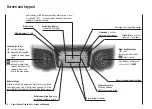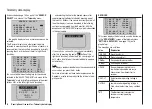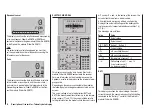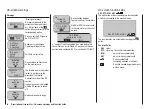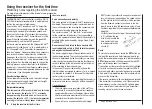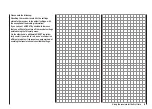
38
Using the transmitter for the first time
Preliminary notes
In theory the
Graupner|SJ
HoTT system permits the
simultaneous operation of more than 200 models.
However, in practice the mixed operation of different
technical systems in the 2.4 GHz ISM band - as required
by the approval regulations - reduces this number
considerably. Generally, however, it will always be pos-
sible to operate even more models simultaneously on
the 2.4 GHz band than on the 35 / 40 MHz frequency
bands which we have used to date. However, the actual
limiting factor - as it has always been - is likely to remain
the size of the (air-) space available. The simple fact that
no frequency control procedure is necessary - a great
convenience in itself - equates to an enormous gain in
safety, especially at flying sites where groups of pilots
may be distributed over a large area, with nobody in
overall control.
Battery charged?
When you take receipt of your transmitter, the battery
will be in the discharged state, so you must first charge
it as described on page 14. If you do not do this, the
battery will soon fall below the pre-set threshold voltage,
and you will see and hear a warning signal to remind
you to recharge it. The threshold
voltage can be adjusted in the
“Battery warning threshold” line
of the “
Basic settings
” menu;
see page 134.
Switching the transmitter on
When you switch the transmitter on, the following display
appears in the centre of the transmitter screen for about
two seconds:
RF ON/OFF?
OFF
ON
Within this period you can switch off the RF signal if
required by moving the black field to the right using the
or
arrows of the right-hand touch-key; when you
do this, ON should appear normal, and
OFF
in inverse
form (black background).
RF ON/OFF?
ON
OFF
You can now switch the RF module off by briefly press-
ing the central
SET
button of the right-hand touch-key.
Until this point the central LED glowed blue, but it now
changes to red, and at the same time the screen switch-
es to the transmitter’s base display:
#01
0:33h
stop
flt
0:00
0:00
0.0V
5.2V
HoTT
M
The symbol combination means that the currently ac-
tive model memory is already “bound” to a
Graupner|SJ
HoTT receiver, but there is currently no connection with
this receiver. (In our example we - of course - switched
off the RF signal!)
In contrast, if you switch the transmitter on without
switching off the RF signal, the central LED glows an
intense blue, and the symbolic transmitter mast flashes.
At the same time the transmitter emits an audible warn-
ing until a connection is made with the corresponding
receiver. Once this connection exists, a field strength
battery
needs
charging
Using the transmitter for the first time
Preliminary notes regarding the
mx-16
HoTT transmitter
For more information please visit our Internet site at www.graupner.de
indicator appears instead of the “x” at the base of the
symbolic aerial, for example
, and the visual and
audible warnings cease.
At the right of the same line a display in the same format
appears when a telemetry connection is made, showing
the strength of the telemetry signal picked up from the
receiver (>
M
) together with the actual voltage of the
receiver power supply.
However, if the symbol combination
appears, and
the central LED glows a constant red, the currently ac-
tive model memory is not “bound” to any receiver.
Low-voltage warning
If the transmitter voltage falls below a particular value,
a visual and audible low-voltage warning is generated.
The default value is 4.7 V, but this can be varied in the
“
Basic settings
” menu (page 134).
Important notes:
The transmitter included in the set is prepared at
•
the factory with the correct settings for most Eu-
ropean countries (except France).
If you wish to operate the RC system in France,
you MUST first set the Country setting on the
transmitter to “FRANCE” mode; see page 135. IT
IS PROHIBITED to use the system IN FRANCE
using the Universal / EUROPE mode!
You can operate up to eight servos using the
•
mx-16
HoTT transmitter and the receiver sup-
plied in the set, which is already bound to the
transmitter.
However, in the interest of maximum possi-
ble flexibility, control channels 5 … 8 are not as-
signed to transmitter controls by default; this
also helps to eliminate the danger of inadvert-
Summary of Contents for mx-12 Hott
Page 1: ...Programming Manual 33116 mx 16 HoTT 3 en mx 16...
Page 35: ...35 For your notes...
Page 49: ...49 For your notes...
Page 55: ...55 For your notes...
Page 59: ...59 For your notes...
Page 63: ...63 For your notes...
Page 69: ...69 For your notes...
Page 91: ...91 For your notes...
Page 101: ...101 For your notes...
Page 123: ...123 For your notes...
Page 181: ...181 For your notes...
Page 193: ...193 For your notes...

